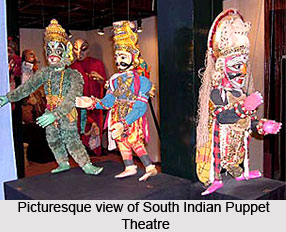Indian Puppet Theatre in Southern India is the conglomeration of the puppetry that is rich with the aromas of the southern region. Uppinakudru Kogga Devanna Kamath is a Gombeyata puppeteer from Dakshina Kannada District, Karnataka. He was born in 1921. Kamath hailed from a family that traces its connection to traditional string puppetry over three centuries. Uppinakudru Kogga Devanna Kamath joined the hereditary troupe founded by his great-granduncle, Lakshman Bhagavata. He trained under his grandfather, Nagappa Bhagavata, and father, Padmanabha Kamath, before they disbanded in 1941. Although forced into urban migration, he returned in 1955, helped his father repair the 300 marionettes lying idle, and revived the group as Sri Ganesha Yakshagana Gombeyata Mandali. In 1971, he took charge after his father`s death. Since then, the troupe has even toured foreign countries to acclaim.
 Togalu Bombeaata is a puppet show that reiterates the stories from Holy Scriptures such as Ramayana and Mahabharata. The shows are thereby performed pertaining to these themes. This is an ancient art form. Through the leather puppet show the main aim is to make more and more people aware of the tales from the religious texts. In Karnataka the people believed that such shows would please rain gods or keep diseases and epidemics at bay. Today Togalu Bombeaata is an interesting form of entertainment for the travellers. It needs great expertise to make lifeless dolls look alive. Togalu Bombeaata, Puppet Theatre is till date practised in the villages of Karnataka. The subjects, however, have not changed. They are still inspired from the popular stories in the mythological texts and others. This mode of entertainment is fast losing its popularity due to the tech age. In rural areas it is still an accepted way of entertainment. Once a ritual it now exists only as a source of entertainment.
Togalu Bombeaata is a puppet show that reiterates the stories from Holy Scriptures such as Ramayana and Mahabharata. The shows are thereby performed pertaining to these themes. This is an ancient art form. Through the leather puppet show the main aim is to make more and more people aware of the tales from the religious texts. In Karnataka the people believed that such shows would please rain gods or keep diseases and epidemics at bay. Today Togalu Bombeaata is an interesting form of entertainment for the travellers. It needs great expertise to make lifeless dolls look alive. Togalu Bombeaata, Puppet Theatre is till date practised in the villages of Karnataka. The subjects, however, have not changed. They are still inspired from the popular stories in the mythological texts and others. This mode of entertainment is fast losing its popularity due to the tech age. In rural areas it is still an accepted way of entertainment. Once a ritual it now exists only as a source of entertainment.
Tolpavakuttu is the leather puppet play. This is an ancient form of shadow theatre that prevailed in Kerala. Only a few families of the Pulavar community of scholar-performers continue the tradition, usually staged in Kali temples during the annual festival of Bhagavati or Bhadrakali. The permanent puppet theatre attached to the shrine is called kuttumatam. The goddess is supposed to witness it, so the playhouse faces the temple. The measurements of an ideal kuttumatam, as in the Kavalapara temple, are 11 m 43 cm in length, 3 m 81 cm in depth, and 1 m 53 cm in height. A thin white cloth covers the front. Behind it is a wooden stand across the length of the stage for the backlights, usually twenty-one oil lamps. Torches also are used for special effects.
Stories from the Ramayana are presented, commencing from Rama`s birth and ending with his coronation. The text consists of twenty-one parts, so the ceremonial theatre season extends for twenty-one nights. The plays have verse and prose dialogue, in Tamil. Originally there was a script specially written for the form. Now it comes from the Kamba Ramayana, by the Tamil poet Kamban in twelfth century. The Pulavars add to it by improvising speeches and varities to emphasize certain situations. They explain the verses and dialogues in a language mixing Tamil and Malayalam.




















